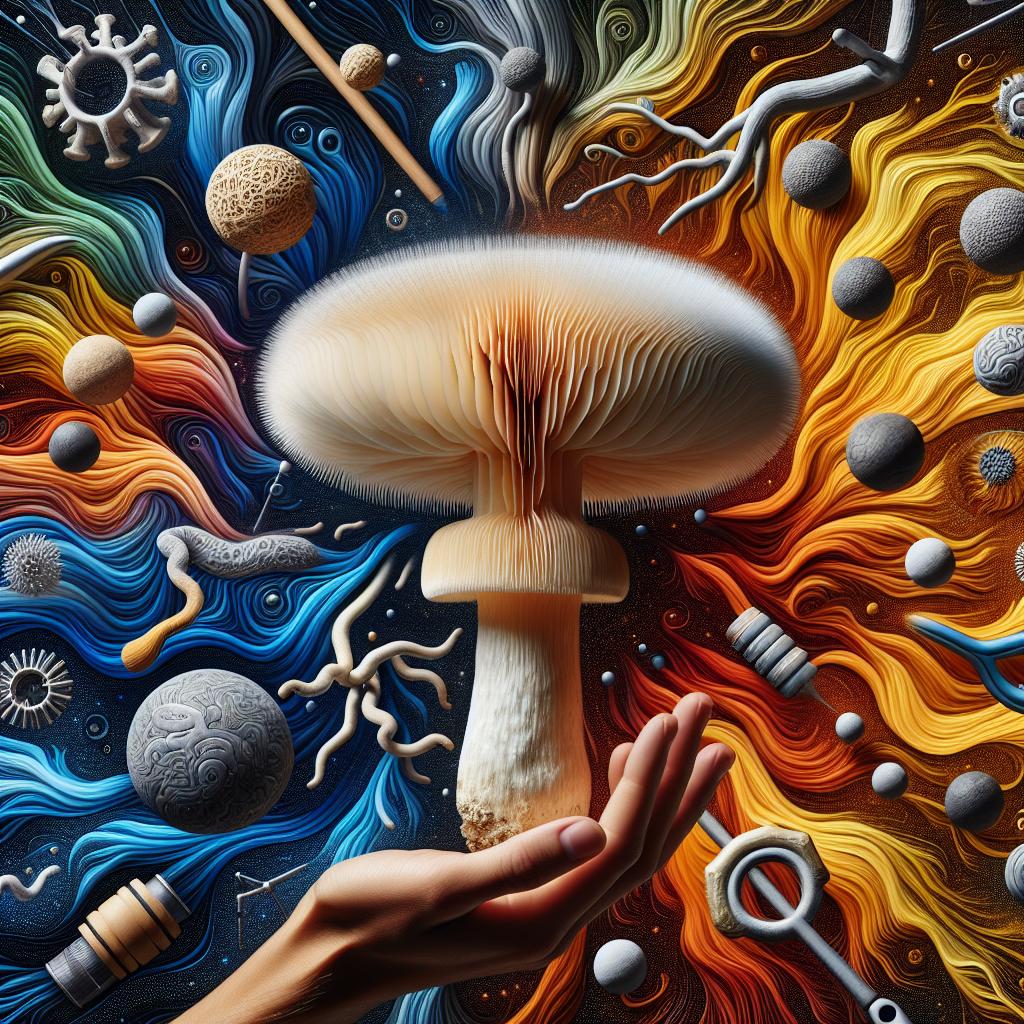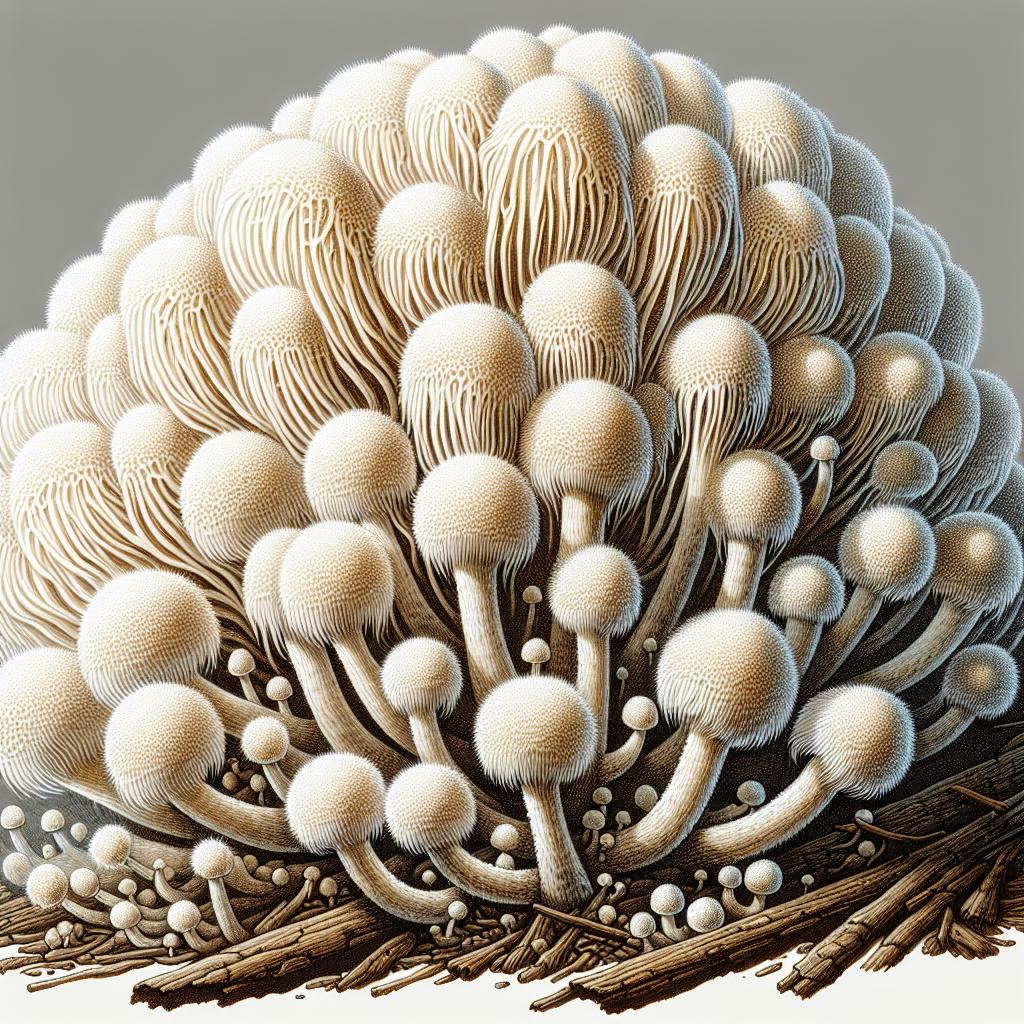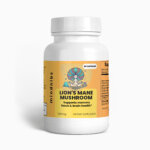
“Mushroom Marvel: What Does Lion’s Mane Mushroom Look Like?”
Imagine for a moment that you’re strolling through the dense underbrush of a verdant hardwood forest. A gentle, earthy scent fills the air as your eyes catch a curious sight—a cluster of what looks like whimsical, cascading icicles or perhaps the well-groomed beard of a wise, old tree spirit. You’ve just encountered the enigmatic Lion’s Mane mushroom, a natural marvel that not only captures the imagination with its unique appearance but also holds secrets to health and vitality that have begun to captivate the minds of culinary aficionados and wellness enthusiasts alike.
But what does the Lion’s Mane mushroom truly look like? It’s a living riddle, with tendrils that seem to dance in the stillness of the forest, an ethereal presence that is both alien and familiar. In the age when exotic fungi are turning heads for their potential benefits, Lion’s Mane stands out like a regal figure, accepted by connoisseurs as a gem of nature’s bounty.
Join us as we venture into the mystical realm of this edible mushroom, unveiling its visual charm that beckons the question—can something this enticing be as beneficial as it is beautiful? Prepare to be whisked away on a magical exploration of Lion’s Mane, the mushroom marvel with a mane as majestic as the animal it’s named after, and discover a visual portrait painted with the brush of nature’s own hand.
Table of Contents
- Unveiling the Unique Appearance of Lion’s Mane Mushroom
- The Mystical World of Mycology: Lion’s Mane Aesthetics
- Distinguishing Features That Set Lion’s Mane Apart
- From Forest to Kitchen: Spotting Lion’s Mane in the Wild
- Lion’s Mane Visual Guide: Texture, Color, and Growth Patterns
- When Beauty Meets Brainpower: Understanding Lion’s Mane Properties
- Culinary and Medicinal Showcase: Lion’s Mane in Your Life
- Harvesting with Care: Tips for Identifying and Picking Lion’s Mane
- The Art of Lion’s Mane Mushroom Photography
- Creating a Sanctuary for Lion’s Mane Growth at Home
- Q&A
- In Summary
Unveiling the Unique Appearance of Lion’s Mane Mushroom

Catch a glimpse of the lion’s mane mushroom, and it’s an experience quite unlike any other edible fungi encounter. Resembling a pompom of the forest, its cascading icicle-like spines hang gracefully, earning it the nickname “the bearded mushroom.” It defies the typical mushroom cap-and-stem silhouette, instead opting for a spherical shape that radiates with long, flowing spindles. True to its namesake, this mushroom is a royal sight to behold, evoking the majestic mane of a lion in all its wild glory.
The colors of this mushroom are a palette pulled from autumn’s own canvas. When young, its tentacle-like spines boast a pristine white, which slowly transitions to a more golden hue as it matures. This color shift is not just captivating – it’s a tell-tale sign of the mushroom’s readiness for harvest. Bold in looks and subtle yet complex in flavor, the lion’s mane mushroom stands out in the wild and in the kitchen alike, offering a visually remarkable and versatile culinary experience.
Apart from its distinguished appearance, what truly sets this mushroom apart is the texture. When cooked to perfection, it gives off a seafood-like consistency—succulent, tender, and slightly chewy. With such characteristics, it’s commonly used as a plant-based substitute for crab or lobster. Just imagine: a faux crab cake or a vegan lobster roll, all thanks to this incredible, shaggy orb.
- Crispy when sautéed to golden perfection
- Delicious when simmered in savory soups
- Divine when pulled apart and used in plant-based seafood dishes
And if you’re a visual learner, feast your eyes on the table below for a quick guide through its distinguishing features at various stages of growth:
| Stage | Appearance | Edible |
|---|---|---|
| Young | Pure White, Dense Spines | Yes |
| Mature | Golden Yellow, Softer Spines | Yes, but best when young |
| Overripe | Brownish, Spread Out | Not Recommended |
Within the forest’s embrace, or exquisitely plated in a gourmet dish, the lion’s mane mushroom is sure to capture the imagination and satisfy the palate. It’s more than just a mushroom; it’s a conversation piece, a visual spectacle, and an invitation to explore the vibrancy of nature’s offerings.
The Mystical World of Mycology: Lion’s Mane Aesthetics

Step into the enchanting realm where the Lion’s Mane mushroom, Hericium erinaceus, reigns supreme—a fantastical creation that could have been plucked straight from a storybook. With its cascading, icicle-like spines, this whimsical fungus presents a sublime beauty that’s hard to miss. Its unique morphology not only captivates the eyes but also captivates culinary enthusiasts and health-conscious individuals alike.
Imagine an undersea world rising to the forest floor, as the Lion’s Mane mushroom resembles the delicate structures of a sea anemone. When young, these globular marvels boast a pristine white complexion, invigorating the forest with ghostly elegance. As they mature, their spines elongate and their color can transition to a more golden hue, hinting at the ancient wisdom they contain. Not just a feast for the eyes, these mushrooms have been revered for their supposed cognitive benefits.
- Size: Can grow up to 15 cm in diameter, resembling a pom-pom of nature’s design.
- Texture: Soft and chewy upon cooking, the spines provide an unusual yet satisfying mouthfeel.
- Color: A vibrant creamy white that ages to a warm yellow or tan.
- Environment: Thriving best on hardwoods, they often grace decaying logs and wounds of living trees.
Let’s not overlook the habitat that these mystical entities inhabit—a tableau of woodland life. Here is a simple guide that captures where you’re likely to find a wild Lion’s Mane mushroom in its natural state:
| Season | Typical Habitat | Visual Cue |
|---|---|---|
| Late Summer to Fall | Deciduous forests | Lone or in small groups on logs and trees |
| Winter | Older growth areas | Silhouetted against the stark bare wood |
Each sighting of Lion’s Mane is an invitation to indulge in the mystical, to explore the unknown corners of our forests. Whether you’re a forager, a photographer, or merely a nature lover, the sight of this majestic mushroom is a clear call to admire and respect the intricate complexities of the natural world. Embrace the allure of these ethereal beings, and you may just unlock a new level of appreciation for the beauty that thrives in the quiet corners of the wild.
Distinguishing Features That Set Lion’s Mane Apart

Imagine stumbling upon a mystical creature from an enchanted forest — that’s the whimsical appeal of the Lion’s Mane mushroom. Unlike your typical button or portobello mushrooms, this shaggy delicacy boasts a cascade of soft, spine-like tendrils that resemble a creamy white version of its namesake’s mane. This distinctive appearance isn’t just for show; it’s a beacon of the unique benefits that lie within.
Color and Texture: A closer look reveals that Lion’s Mane mushrooms gleam with a lustrous sheen, presenting hues that range from pure snowy white to a delicate beige as they age. The textures are equally entrancing, beginning plush and spongy in youth, transitioning to a more fibrous feel over time. Rest assured, when you spot one, its captivating form is hard to overlook amidst the forest’s foliage or on your grocer’s shelf.
- Size Matters: Generally, these woodland treasures grow to impressive sizes, anywhere from 5 to 40 centimeters in diameter. Their substantial size not only makes a statement in the wild but promises a hearty addition to any dish on your dinner table.
- Forest Habitat: True to its feral origins, Lion’s Mane prefers the company of hardwoods, especially the welcoming nooks of dead or dying trees. This habitat hints at its role in the ecosystem as a decomposer, showcasing that beauty can indeed stem from the cycle of life and regeneration.
The edible gem’s shape is yet another distinctive trait, often mimicking a clump of cascading icicles or the elegant drape of a waterfall. This irregular, gravity-defying structure not only turns heads but also reveals a complex architecture, optimized for dispersing its spores. Below is a quick glimpse of what makes this mushroom stand out.
| Feature | Description |
|---|---|
| Structure | Irregular, cascading |
| Texture | Spongy to fibrous |
| Color | White to beige |
| Size | 5-40 cm diameter |
| Habitat | Hardwood forests |
Intriguing in form and function, the Lion’s Mane mushroom stands out as a natural wonder among its fungal relatives. Its distinct features not only serve as a talking point for foragers and foodies alike but also symbolize the mushroom’s rich composition and versatile culinary potential. Next time you’re piqued by the peculiar, consider this marvel from the mushroom kingdom — it might just transform your perception of the forest’s flora, and quite possibly, your next meal.
From Forest to Kitchen: Spotting Lion’s Mane in the Wild

Embarking on a foraging journey, you might wonder how to spot the elusive Lion’s Mane mushroom, a culinary gem hidden within the forest’s embrace. Picture this: you’re wandering through a deciduous woodland, the kind where hardwood trees stand tall, and amongst the symphony of nature’s hues, a remarkable organism stands apart with its cascading, icicle-like spines. These spines, shaggy and pure white, are the telltale signs of Lion’s Mane, also known by its scientific moniker, Hericium erinaceus.
Unlike other wild fungi that prefer the concealment of the earthy ground, Lion’s Mane adorns standing trees or fallen logs with its presence. Keep an eye out for aging or wounded trees; these are the chosen canvases for this mushroom’s artistry. What’s fascinating is the contrast it creates against the rough, dark bark – a beacon for foragers. This fungi’s choice of habitat, hitching on hardwoods like oak, maple, or beech, is not just an aesthetic decision, but a survival strategy, decomposing wood and returning nutrients to the forest floor.
Indeed, Lion’s Mane possesses an air of the extraordinary, but it’s not only sight that will guide you to this forest treasure; sense of touch is equally alluring when differentiating it from look-alikes. Allow your fingertips to graze the surface, feeling the softness reminiscent of the mane for which it was named. Its unique texture is unparalleled – neither slimy nor dry, but tender and spongy to the press. Below, a simple table highlights the key visual identifiers:
| Feature | Details |
|---|---|
| Color | Pure White to Creamy |
| Shape | Globular with Cascading Spines |
| Texture | Tender and Spongy |
| Habitat | Hardwood Trees (Alive or Decaying) |
In your search, you might also uncover impostors along the way, such as the Bear’s Head Tooth mushroom, which can potentially confuse the untrained eye. Exercise awareness and carry a field guide or use a trusted mobile application to confirm your findings. When in doubt, forage with an experienced guide. Remember, one of the joys of mushroom hunting is learning, and every trip to the woods enriches your understanding of this natural kingdom. Spotting Lion’s Mane is an achiever’s milestone, a step closer to nature’s intimate culinary secrets, just waiting to be discovered and savored from forest to kitchen.
Lion’s Mane Visual Guide: Texture, Color, and Growth Patterns

Step into the natural gallery of fungi, and you’ll be greeted by a spectacular specimen – the Lion’s Mane mushroom. It’s as majestic as its namesake, with a unique cascading spines texture that mimics a waterfall of miniature icicles. This edible mushroom stands out not only for its health benefits but also for its exceptional characteristics that are a feast for the eyes.
The first thing to notice is its color palette. When it’s young, you’ll witness a pristine white that could rival fresh snow on a winter morning. As it matures, the hue transitions to a more creamy or yellowish color, a tell-tale sign of a Lion’s Mane that’s reached its peak and is ready for harvest.
- Young Specimen: Ivory White
- Mature Specimen: Cream to Yellowish
Exploring further, the texture of the Lion’s Mane is both intriguing and delightful. Unlike the common smooth or gilled mushrooms, this variety boasts a shaggy appearance, composed of elongated spindles. These dangle loosely, creating a soft, touchable surface that’s unlike any other fungi. The spines are thicker at the base and taper gently to a finer point, much like the mane of the animal it’s named after.
| Stage of Growth | Texture Description |
|---|---|
| Young | Dense and Firm |
| Mature | Loose and Flowing |
Lastly, the growth patterns of Lion’s Mane are as fascinating as its form. It typically anchors itself to dead or dying hardwood trees, flourishing in cool, moist environments. Unlike other mushroom species that expand outward, Lion’s Mane grows in gravity-defying droops and clusters, which can create a striking visual when multiple mushrooms colonize a single host. Its propensity for vertical spaces makes it a remarkable sight in the dense green canvas of the woods.
- Host Trees: Often Hardwoods like Beech or Oak
- Environment: Prefers Cool, Moist Conditions
- Arrangement: Clusters, Often in Vertical Alignment
When Beauty Meets Brainpower: Understanding Lion’s Mane Properties

The allure of Lion’s Mane mushroom extends beyond its striking appearance; this cerebral fungus is making waves for its medicinal savvy. Often compared to seafood in taste and texture, its shaggy, white cascades make it readily distinguishable from its fungal brethren. An organic symphony of spines, reminiscent of a lion’s luxurious mane, falls from a single, condensed stalk, cementing its royalty among mushrooms.
But this isn’t just a feast for the eyes. Venture deeper, and you unearth a treasure trove of benefits that could revolutionize modern wellness. As if plucked from the pages of nature’s own apothecary, Lion’s Mane boasts nootropics that cater to cognitive enhancement and neural growth. Imagine fortifying your brain as you would your body at the gym – with Lion’s Mane, that notion isn’t far-fetched.
- Neuroprotective Qualities: Famed for supporting nerve growth factor (NGF) synthesis, an essential player in the maintenance and regeneration of neurons.
- Memory and Focus Enhancement: Enthusiasts report improved concentration and cognitive function, perhaps a game-changer in the distraction-laden digital age.
- Mood and Anxiety Support: An ally against the unseen enemies of mood disorders and stress, imparting a natural veil of calm.
| Constituent | Benefit |
|---|---|
| Hericenones | Stimulate NGF synthesis |
| Erinacines | Potentiate neurogenesis |
| Beta-Glucans | Enhance immune system |
| Antioxidants | Combat oxidative stress |
Dive into the ocean of possibilities that is Lion’s Mane mushroom and emerge with a sharper mind and a harmonious soul. The potential locked within its ethereal tendrils is waiting to be harnessed, perhaps changing the landscape of your mental and physical equilibrium. Embrace the elegant complexity of this mushroom marvel—where beauty impeccably intertwines with brainpower.
Culinary and Medicinal Showcase: Lion’s Mane in Your Life

Nature has a penchant for designing the extraordinary, and when it comes to Lion’s Mane mushroom, the creativity is certainly on display. Envision a delicate waterfall of white, cascading tendrils resembling a pom-pom or the luxuriant mane of a mythical lion. This unique fungus doesn’t just captivate with its looks; it’s a treasure trove of flavors and health benefits, just waiting to be explored in your culinary adventures and wellness regimen.
Bring a Touch of Gourmet to Your Plate
- Mimic the texture of succulent seafood in vegetarian dishes.
- Enhance soups and sauces with its rich, savory umami.
- Experiment with frying or roasting to add a satisfying crunch to salads.
But the magic of Lion’s Mane extends beyond the frying pan. As both a gourmet delight and a traditional remedy, this mushroom has been linked to a cornucopia of medicinal benefits. Incorporating this natural wonder into your life could be an investment in your long-term health.
Unlock the Potential of Your Mind and Body
- Promote mental clarity and focus, nudging your cognitive function to new heights.
- Find solace in its potential to soothe and rehabilitate nerve damage.
- Embrace the possibility of an immune system bolstered against the trespasses of illness.
| Nutrient | Benefit |
|---|---|
| Antioxidants | Combat oxidative stress |
| Beta-glucans | Support immune health |
| Noocytropics | Enhance brain function |
Integrating this edible marvel into your routine might just be the beginning of a transformative journey for your palate and well-being. So why not let the Lion’s Mane mushroom roar into your life with its culinary versatility and medicinal prowess? The adventure is as delicious as it is beneficial.
Harvesting with Care: Tips for Identifying and Picking Lion’s Mane

Embarking on a foraging adventure for Lion’s Mane mushrooms can be both exhilarating and rewarding. To ensure your harvest is bountiful and sustainable, discerning the right specimens is crucial. First and foremost, attentiveness to the mushroom’s unique characteristics is key. Look out for the telltale cascading icicle-like spines, a distinctive trait that sets the Lion’s Mane apart from its fungal peers. Typically, you’ll find them adorned on hardwood trees, especially during late summer to fall.
When it comes to the actual picking, gentleness is paramount. This not only helps preserve the delicate ecosystems where these treasures thrive but also maintains the integrity of the mushroom itself. Gently cradle the base and twist it off the wood; a softly-softly approach will minimize damage to both the tree and the fruiting body. It’s essential to harvest only what you need, leaving behind enough to ensure the future growth and sustainability of this remarkable species.
- Investigate thoroughly: Inspect your find to be certain it’s Lion’s Mane and not a lookalike.
- Maintain cleanliness: Use a small brush to remove any debris or insects from the spines before placing it in your collection bag.
- Respect local regulations: Always comply with regional foraging guidelines to keep the mushroom habitats pristine for future generations.
For those keen on tracking their Lion’s Mane encounters, a handy visual log comes in useful. A simple table can keep your findings organized, noting the location, date, and conditions of each harvest. Here’s a basic template you can use to create your own ledger:
| Date | Location | Environment Conditions | Observations |
| April 15 | Whispering Pines | Moist, after a rain | Found 3 mature specimens, on a maple tree. |
| April 22 | Boulder Creek | Overcast, early morning | 2 young, 1 fully grown, near a fallen oak. |
Taking the time to properly identify and sustainably harvest Lion’s Mane mushrooms not only ensures that you enjoy the spoils of your pursuit but also that you contribute to the health of the ecosystem. Nature’s bounty is plentiful, but it is contingent on the care and effort we put into preserving it. Go out, forage with respect, and the Lion’s Mane will continue to be a stunning marvel of woodland wonders.
The Art of Lion’s Mane Mushroom Photography

Capturing the mystique of the lion’s mane mushroom through the lens of a camera is akin to preserving a moment of natural wizardry. These ethereal fungi are not your typical grocery-store mushrooms; their cascading icicle-like spines emanate an otherworldly beauty. To photograph them, timing and lighting are your most devoted allies. Await the golden hour when soft, warm hues drape gently across the forest, highlighting each intricate detail and transforming the ordinary into the extraordinary.
With a backdrop as rich and inviting as the woodland floor, the lion’s mane mushroom commands attention. Use a shallow depth of field to isolate your subject, allowing those luscious tendrils to stand in stark relief against a dreamy, blurred backdrop. A tripod steadies your shot, permitting a lower ISO and reducing noise, ensuring the mushroom’s intricate textures are crisply front and center.
- Consider the angle: A low vantage point can provide a sense of grandeur, elevating the mushroom to majestic proportions.
- Experiment with composition: Try the rule of thirds or frame within a frame to add depth and interest.
Remember, these sentient spires are not merely static subjects; they thrive in a living, breathing ecosystem. To tell their story, embrace the elements around them. A fallen leaf or a glistening water droplet can become a crucial character in your composition, providing context and texture. Perhaps even consider a touch of post-processing magic to bring out those delicate details and enrich the colors to suit the mood you’re aiming to convey.
| Camera Setting | Tip |
|---|---|
| Aperture | Use f/2.8 – f/5.6 for bokeh effect |
| Shutter Speed | 1/125 sec or faster to eliminate shake |
| ISO | Keep it as low as possible |
| White Balance | Adjust for the environment’s color temperature |
While technical prowess is crucial, the true essence of lion’s mane mushroom photography lies in your connection with the subject. Imbue your images with emotion, and let viewers peek through your eyes—discovering not just what these mystical fungi look like, but also how they make you feel. After all, a picture may be worth a thousand words, but a great photograph of a lion’s mane mushroom speaks directly to the soul.
Creating a Sanctuary for Lion’s Mane Growth at Home

Imagine transforming a corner of your home into a lush refuge for one of nature’s most fascinating fungi: the lion’s mane mushroom. This magnificent specimen, with its flowing, cascading spines, resembles a soft, white waterfall, and bringing it into your dwelling not only adds an element of serene beauty but a flurry of health benefits as well.
Firstly, select a locale that’s out of direct sunlight yet still embraces the soft kiss of indirect light—a sweet spot that mimics the dappled understory of a hardwood forest, the mushroom’s natural habitat. Your sanctuary should also be stable in terms of temperature, maintaining a consistent range between 15-24°C (60-75°F), with a sweet spot around 21°C (70°F) to encourage optimal growth.
- Moderate Humidity: A hydration haven, usually between 85-95% humidity, to keep your mushrooms plush and prosperous.
- Subtle Ventilation: A light, gentle air exchange to whisper away carbon dioxide and beckon fresh oxygen, mimicking the breath of the forest.
- Minimal Disturbance: A peaceful quarter, where the mushrooms can bask in tranquility, free from the hustle and bustle of household activities.
| Environment | Requirement |
|---|---|
| Lighting | Indirect, filtered light |
| Temperature | 15-24°C (60-75°F) |
| Humidity | 85-95% |
| Ventilation | Gentle Air Exchange |
By curating these conditions, you’re not just cultivating mushrooms; you’re crafting a serene ecosystem within your own home. One that whispers ancient forest secrets and nurtures a living organism renowned for its intriguing shape and possible cognitive benefits. The lion’s mane mushroom isn’t merely a denizen of your home—it becomes an inviting symbol of natural splendor and well-being, a living work of art unfurling its graceful tendrils right before your eyes.
Q&A
### Mushroom Marvel: What Does Lion’s Mane Mushroom Look Like?
**Q: Can you describe the allure of the Lion’s Mane mushroom for a nature enthusiast?**
A: Absolutely! Imagine wandering through a lush forest, where the symphony of the wild hums in the background. Amidst the verdant flora, you spot a whimsical sight that looks as if it has sprung right out of a fairy tale. There, clinging to a sturdy hardwood tree, is the Lion’s Mane mushroom—a captivating, cascading waterfall of soft, white tendrils. Its ethereal beauty is reminiscent of a mythical creature, inviting a sense of wonder and admiration for the marvels of nature.
**Q: I’m curious, what exactly does this mushroom look like? Could you paint a picture for me?**
A: Picture this: the Lion’s Mane mushroom, also known by its scientific name *Hericium erinaceus*, bears an uncanny resemblance to a pom-pom of the natural world. It boasts long, shaggy spines that dangle like a lion’s majestic mane, radiating outward from a single, hidden base. Each spine is delicate, soft to the touch, almost creamy-white in color, and altogether forms a globe of mesmerizing, intricate patterns.
**Q: Is it true that the Lion’s Mane mushroom has a unique presence in the wild? How would I identify it?**
A: Indeed, the Lion’s Mane mushroom carries an aura of intrigue that sets it apart from its fungal kin. To identify this gem in the wild, keep your eyes peeled for its distinctive, bushy clusters which can range from a petite 5 centimeters to a grand 40 centimeters in diameter. It favors the sturdy trunks and fallen branches of hardwoods, particularly in late summer and fall. What makes it striking is its contrast against the earthy backdrop—the Lion’s Mane mushroom is like a beacon of soft, snow-white light amid the rustic tones of the forest.
**Q: So, does this remarkable appearance signify any special properties?**
A: The charm of the Lion’s Mane mushroom is more than skin deep. This mushroom isn’t just a feast for the eyes; it’s a powerhouse of potential health benefits. Touted for its cognitive-boosting properties, it’s a darling of the superfood world, with research suggesting it may support neural growth, enhance memory, and provide a mental clarity like no other. Its alluring beauty is matched by its promise of vitality, making it a sought-after marvel for the health-conscious.
**Q: Are there any interesting lore or legends associated with Lion’s Mane mushrooms?**
A: Lion’s Mane mushrooms carry with them a tapestry of historical reverence and mystique. In traditional Chinese medicine, they were seen as a tonic for the mind and spirit—a true neurological nectar. The ancients believed that consuming this mushroom would grant not only longevity but also the wisdom of a lion, symbolizing the seamless bond between nature’s wonders and human well-being.
**Q: If I’m convinced, how can I start incorporating Lion’s Mane into my life?**
A: Embracing the splendor of Lion’s Mane into your daily routine is simpler than you might think. This versatile mushroom can be cooked and savored in culinary dishes or taken as a supplement in powder, tincture, or capsule form. Infuse your morning smoothie with a dash of its powdered glory, or savor it sautéed as a gourmet side dish. Whichever you choose, you invite not just a piece of nature’s magic into your life, but a companion for your wellness journey.
Lion’s Mane isn’t merely a mushroom; it’s a symbol of the enchanting interplay between health and the great outdoors. Its exceptional appearance is your gateway to a realm of vitality, a visual treat and a tribute to nature’s astonishing creativity. Why not let this unique marvel weave its wonder into your life and witness its manifold gifts firsthand?
In Summary
As we draw the curtain on our mycological journey, we hope the image of the Lion’s Mane mushroom now dwells vividly in your mind’s eye—a cascading waterfall of soft, tooth-like spines, an ivory treasure hidden within the forest’s emerald embrace. This mysterious marvel is more than just a feast for the eyes; it’s a tribute to nature’s boundless creativity and a reminder of the hidden gems awaiting those who seek the wonders of the natural world.
Let the Lion’s Mane inspire more than mere curiosity—consider it an invitation to explore the extraordinary, to connect with the subtle artistry of our environment, and to embrace the wild tapestry of life that flourishes beneath our feet. Whether you’re a foraging enthusiast, a culinary connoisseur, or simply a nature lover, the world of fungi offers endless intrigue and holistic treasures.
Before you return to the rhythm of your daily life, take a moment to reflect on the enchantment of the Lion’s Mane. Dare to deeper, to learn more, and perhaps to even seek out this elegant organism for yourself. Who knows what other marvels you may discover when you open your eyes to the beauty of the fungi kingdom?
Join the ranks of those enthralled by the power and poetry of Lion’s Mane mushroom. Embrace the intrigue. Indulge in the magnificent. Share in the marvel. Your next great discovery awaits.

























